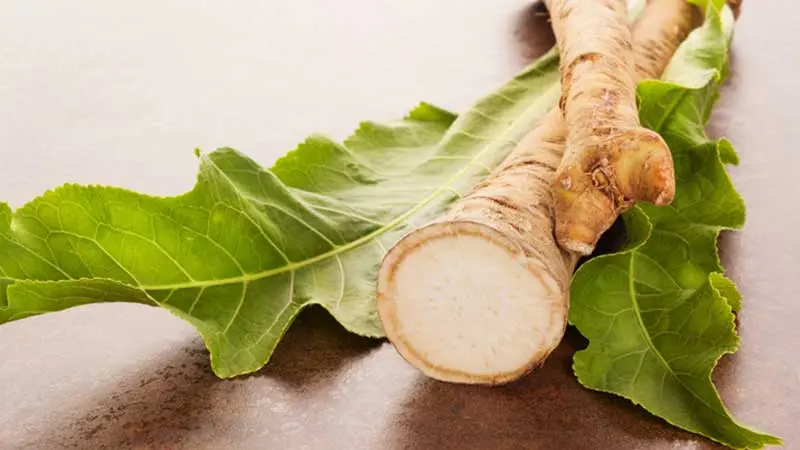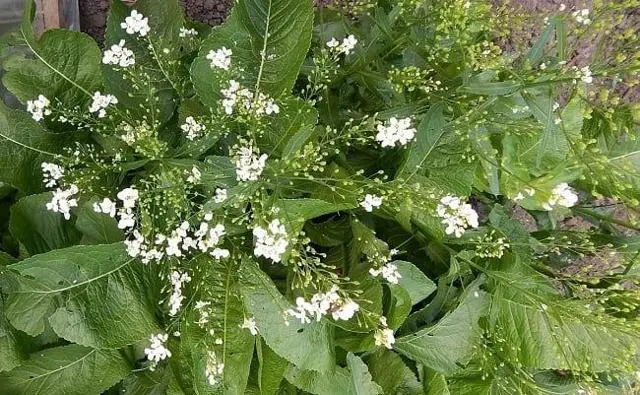Contents
Horseradish is a perennial plant that is resistant to temperature fluctuations and frost. In the regions of Eurasia, where there is no permafrost, horseradish grows everywhere. Its roots “choose” river banks and areas not far from other water sources in the wild. The perennial belongs to the Cabbage family. It grows up to 1.5 m in height, and the length of its leaves can reach 50 cm and even a little more.
The plant blooms from the beginning of July to almost the end of summer; there are 4 seeds in a pod box. As a nutritious product, you should consider and use horseradish root strictly, but both the plant’s leaves and the juice from its roots are effective for medicinal purposes. The benefits of horseradish for the body are wide. In folk medicine, people consider the plant as “seven troubles – one answer.”
Varieties
Cultivated horseradish has many varieties that amateur gardeners grow in their backyards. However, it is important to remember that this plant tends to grow rapidly, so you should place it around the plots’ periphery.
Horseradish’s closest relatives are radishes, mustard, and watercress. People believe that this plant was popular in times of ancient Greeks and Romans. Horseradish is an easily spreading plant, and you can find it in the wild in many countries. However, most botanical scientists believe that this spicy-aromatic plant has a native Russian origin.
Even before our era, the ancient Greeks began to eat this spicy and bitter dish. They believed that horseradish stimulates appetite and activates vitality. Besides, they often used it to prepare ointments for rheumatism.
For medicinal purposes, as well as for culinary purposes, horseradish roots are good to use. It would help if you harvested them in the autumn. And the best way to store them is by placing them in damp sandboxes, cellars, or basements. It is better to store this plant at a temperature from -1 to +1 C. Horseradish roots appear in the Pharmacopoeia of many countries, such as Switzerland, France, Brazil, and others.

Horseradish is a traditional seasoning for fish and meat dishes. You may use its leaves for salting vegetables and making marinades. The most popular spice is grated horseradish. It significantly improves the taste of food, giving it a piquancy and a special aroma and stimulating the appetite.
Horseradish chemical composition
It contains mono- and polysaccharides, protein compounds, and organic acids, minerals, and starch, as well as a rich vitamin complex. It also contains enough amount of fats, nitrogenous and resinous compounds.
The perennial includes:
- iron;
- magnesium;
- aluminum;
- chlorine;
- calcium;
- sulfur;
- sodium;
- copper;
- manganese;
- phosphorus.
The most valuable vitamins of group B are especially abundant in the product. Folic acid and pyridoxine, niacin and thiamine, riboflavin – ordinary horseradish are highly rich in all of these components.
By the way, the plant contains 6 times more vitamin C than lemon, which means horseradish is an excellent product for healing colds. And the specific smell of the perennial is given by essential oils that accumulate at the very base of the roots.
And these are not just the elements responsible for the smell: essential oils are having anti-inflammatory and bactericidal properties.
Healing properties

Traditional healers must include the plant in the home medicine cabinet. They know that the plant heals the body, helps the liver work effectively, has a beneficial effect on blood pressure, and increases male potency.
10 main properties of the product:
- Fermentation in the intestinal cavity gives a person not just discomfort but real suffering. Horseradish consumption nullifies this negative process.
- Facilitates perennials and removes phlegm from the respiratory tract, which means it makes the cough productive and speeds up recovery.
- The product is beneficial for people with diabetes as well. It improves the patient’s condition, stabilizes the improvement.
- To avoid the development of urolithiasis, you also need to eat horseradish. This applies to both women and men.
- Stomatitis is an unpleasant ailment at any age. If you suffer from it or complain of bleeding gums, recipes with a hot product will be helpful and will take effect quickly.
- You can also cleanse the body of parasites with the help of this perennial.
- Horseradish is a plant that helps fight puffiness and removes excess fluid from tissues.
- Compresses with a grated product are an effective remedy for radiculitis and rheumatism, arthritis, and gout.
- For a long time, a burning product was helping to get rid of furunculosis.
- Together with carrots and beets, horseradish helps to stabilize high blood pressure in hypertension.
- You can often see recipes where horseradish root helps improve liver function. It is also healing hepatitis (only after consultation with the attending physician).
When horseradish is harmful

- A pungent aroma, a burning taste is always an effect on the mucous membrane. You can use horseradish with benefits, but health damage is quite likely to happen if you abuse the product. You don’t need to eat it every day.
- If you have a pathology of the digestive tract, then do not take horseradish during an exacerbation, even in small quantities.
- With pancreatitis and exacerbated kidney pathologies, you should not consume horseradish.
- Please do not give it to children under 8.
- The product is not good for women carrying a child, as well as for nursing mothers.
This product can be dangerous for people with thyroid pathology.
If a woman’s periods are heavy these days, it is worth giving up horseradish, as its use can increase bleeding.
In case of an overdose, a person may increase pressure; even the development of bleeding may be possible.
Home horseradish – recipe
Ingredients
- Beetle grain 0.5 kg
- Red beets 1 piece
- Sugar to taste
- Salt to taste
- Table vinegar to taste


Check out the recipe below on how to cook a tasty horseradish sauce:









